Introduction and Acknowledgements
(A section of the NICEVILLE, FLORIDA - Online History Center)
“The challenge of history is to recover the past and introduce it to the present."~David Thelen
The Purpose of This Website
This is an educational, not-for-profit website to present documentation establishing the early history of Historic Niceville, Florida - "Gateway to the Bay Country".
There is now sufficient documentation, including exact locations, to obtain markers for Niceville’s oldest historical sites. A June 1972 DeFuniak Springs Herald-Breeze article reported a meeting of the trustees of the Okaloosa-Walton Historical Society on May 23, 1972. Cebelle Meigs envisioned some historical markers when funds were available. In 2006 Jack Nichols expressed his interest in marking the city’s history and offered to fund a marker for the Nathey Gristmill established in 1857. Historical markers are needed for the locations of the Nathey Gristmill, the original Boggy/Niceville post office, the Niceville Hotel, the sawmills, the docks, the fishhouses, the shipyard, the first schools and churches, the Woodmen of the World home, the Choctawhatchee Forest Ranger Station and the Civilian Conservation Corps camp site for Forest Co. 1402 and Army Co. 1413 near Jackson Guard.
Historical Markers Dedication and Unveiling
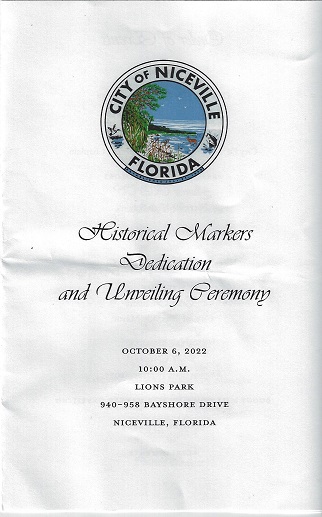 |
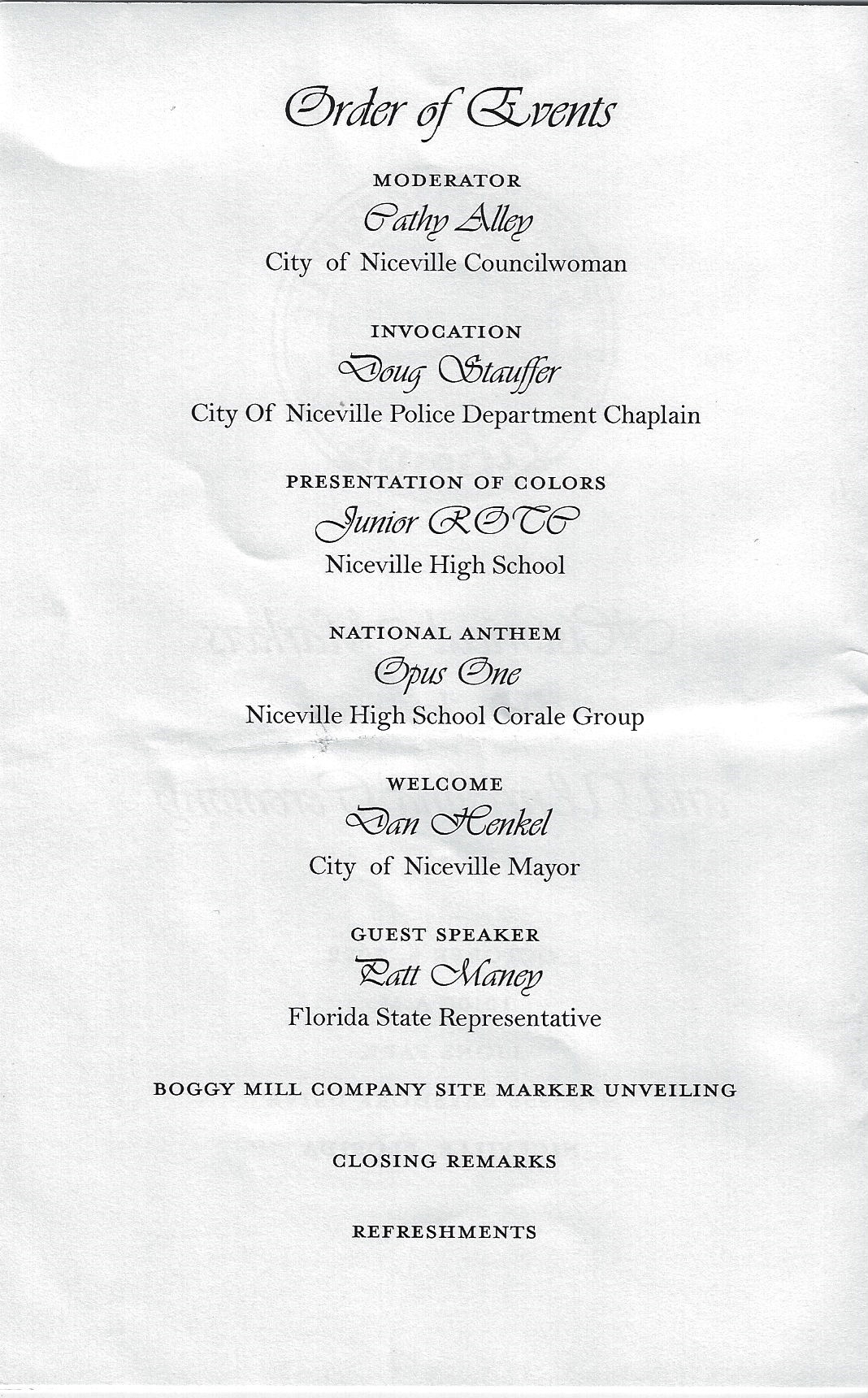 |
Mayor Dan Henkel's opening remarks on October 6, 2022: On behalf of the city, it is my honor to welcome you to Niceville's Historical Markers Dedication and Unveiling. You have arranged your schedules to be with us this morning and we are grateful to have you here to celebrate some of the earliest history of our city.
Looking around this area today with the nearby residential and commercial development, we can only imagine what the landscape was like in the early part of the last century.
We can, however, get some idea from John T. Faris, an editor, author, traveler and Presbyterian minister. In 1921 'Seeing the Sunny South' his extensively detailed book with photographs, was published.
He described the Forest in this area, with its impressive live oak trees and stated that a visit to the forest should be part of a trip to the South beginning on what he describes as "a good automobile road from Crestview to Niceville and on to Boggy Bayou and from that point to Camp Pinchot Ranger Station. There is no ride like this in all of Uncle Sam's vast domain, among the live-oaks, the cypress and the long leaf pines, which rise forty to sixty feet before spreading out their dense foliage. Along the road one seems to be riding through the arches of a cathedral."
The author states the trip continued out to the "mouths of Choctawhatchee River, up La Grange Bayou, Rocky Bayou and Boggy Bayou, back to Niceville and the motor road that stretches through the forest to Crestview and the railroad."
While it is hard to imagine the numerous live-oaks, cypress trees and long leaf pines that John Faris described in his book, looking around us today where we gather to picnic, enjoy water views and observe our 4th of July Fireworks, one would have no idea that there once was a 40 acre lumber mill located here, that in 1934 the old downtown area of Niceville had ten commercial buildings destroyed by fire, or that ships were built here in the late 1800s or that Niceville was the major regional fishing center. The historical markers being dedicated today help to tell the earliest story of our city as Niceville now has three Florida Heritage Sites.
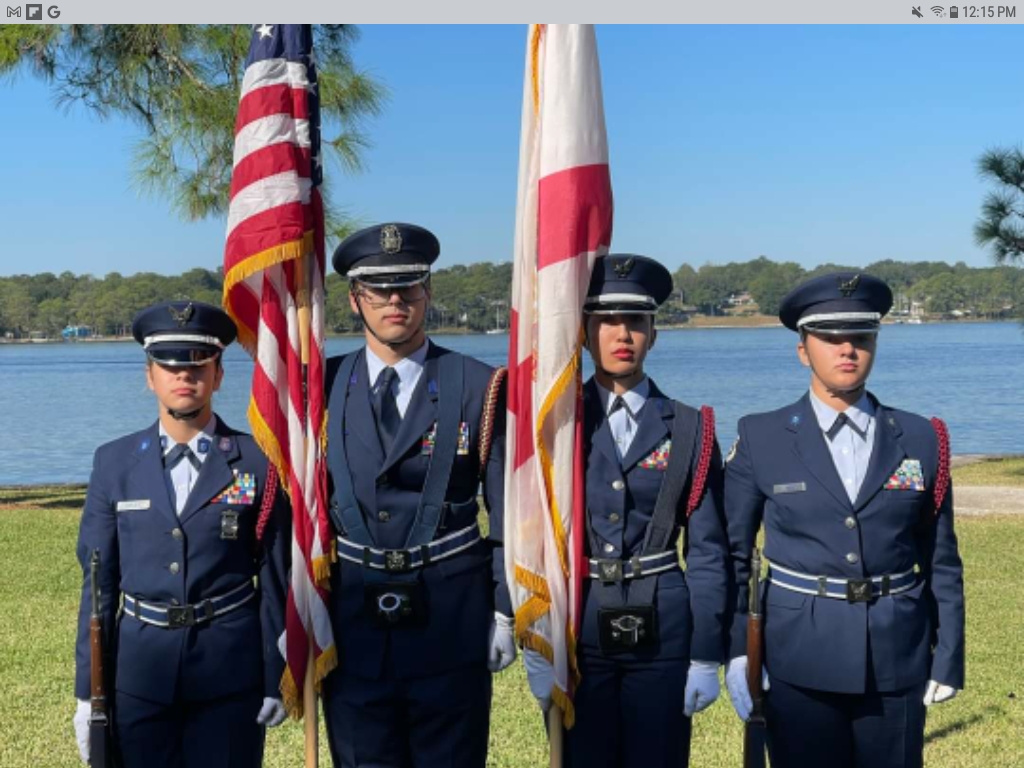 |
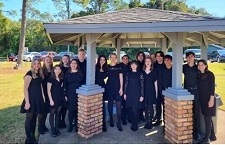 |
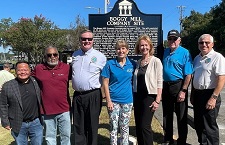 |
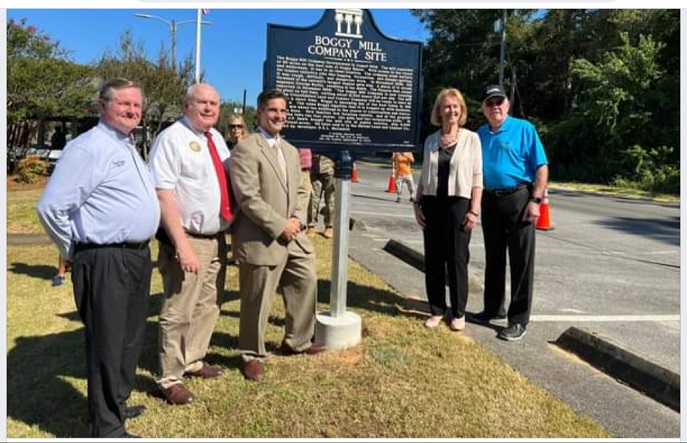
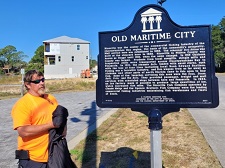 |
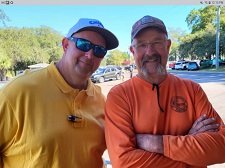 |
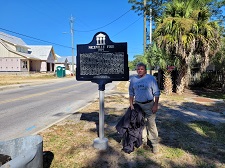 |
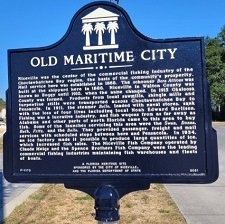 |
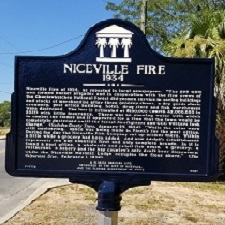 |
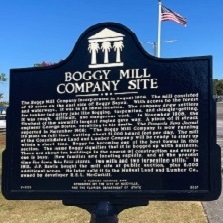 |
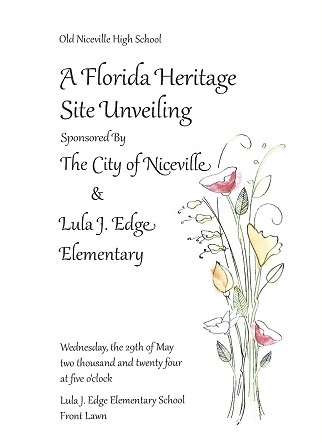 |
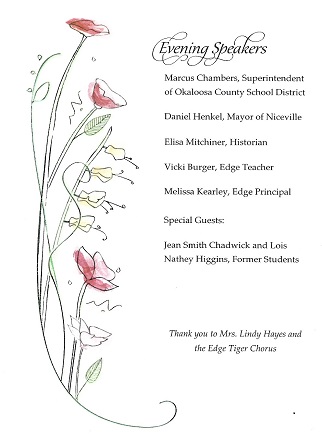 |
|
On May 29, 2024 the fourth Florida Historical Marker was dedicated for the Old Niceville High School. The speaker for the event was Elisa Mitchiner. Her tireless and selfless efforts to document the school history and then working through the arduous vetting process to get approval finally resulted in the State of Florida recognizing the school as a Florida Heritage Site. Her presentation reads as follows: Thank you for being here to celebrate the unveiling of the Old Niceville High School historical marker. Have you visited Niceville's first three historical markers along Bayshore Drive? Have you visited the CCC Worker Statue at Turkey Creek Park? The Worker Statue is number 77 along the CCC Legacy Trail across the nation from Connecticut to California. Some of you represent successive generations of students on this campus. Some descend from the 185 households in the 1920 Niceville Federal Census. If you are a member of a family that has two or more generations that attended this school, please raise your hand. In 1921 the Okaloosa News Journal reported that the School Attendance Law passed by legislation in 1919 requiring children ages 7 to 16 to attend school would be enforced. Three years later George Nathey donated land on the William John Nathey Homestead for the first Niceville High School. Completed in 1925 as an all-grades school, perhaps it was an effort to consolidate the three schools depicted on the 1908 Walton County Farm Map when Niceville was in Walton County. In December 1926, a fire completely destroyed the school. A new building was constructed and ready for the 1928 school year. The 1930 Niceville Federal Census was taken during The Great Depression. Niceville had 202 households and a population of 824. It was the first census for Valparaiso, taken from a portion of old Niceville on the west side of Boggy Bayou. Valparaiso had 38 households and a population of 99. Have you heard of Camp Bigby? We are gathered where ninety-one years ago on May 19, 1933 Civilian Conservation Corp Company 1402 F-3 arrived here and set up its temporary tent camp while their wooden barracks and other structures were built across the highway adjacent to the Jackson Ranger Station. It was one of the first CCC camps in the nation and the first in the state of Florida. Niceville was the most populated election precinct in the southern region of Okaloosa County with 1,172 residents in the 1935 Florida State Census. Valparaiso had 166 residents. For the second time in its relatively short history, Niceville High School was again completely destroyed. This time by a hurricane in July 1936. Being heavily bonded for two destroyed buildings, the school continued to operate in an old dance hall building on "Howell Hill" in Niceville. The Niceville school was one of the county's most badly needed projects. With limited funding in 1937 the Okaloosa County School Board petitioned the United States Congress to grant aid for school construction as a part of the Emergency Division of the Works Progress Administration. Aid was granted and work was started. The structure built by the WPA was described as a splendid, modern school building which would provide for the needs of the community for a long while. The auditorium, heating system and electrical wiring were to be added when additional funds were secured. An article in the Okaloosa News Journal in March 1938 reported that Miss Lula J. Edge had announced her candidacy for re-election to the county school board. Her outstanding contribution had been the work of replacing the destroyed Niceville High School building. In July 1938 the Okaloosa News-Journal reported that an election was held showing overwhelming sentiment for a proposal to incorporate Niceville. The vote was 329 to 4. On May 18, 1939 Bob Sikes introduced House Bill No. 1302 to the Florida Senate to "establish a municipality of the City of Niceville". The bill was approved and Niceville was officially incorporated May 25, 1939. The Valpariso (sic) News and West Florida Review reported in December 1939: "Niceville bears the distinction of being one of the earliest settlements in Okaloosa County and has for many yeas been the center of the commercial fishing industry of the Choctawhatchee Bay region. Here also is located the High School of the southern section of Okaloosa County. The CCC maintains a large encampment just outside the city limits. There is much historic backgound also in and around Niceville one being that of the story of an old mill built prior to the Civil War and which is still located on the Golf Course of the Valpariso (sic) Country Club, adjacent to Niceville." In 1943 it was the first school to have a nine-month school term for Eglin Field military families. The Niceville High School Class of 1952 was the last class to graduate from this location. The Junior Class had the distinction of being among the first graduating class at Choctawhatchee High School in 1953. The Niceville High School name changed to Niceville Elementary in 1952 and then to Lula J. Edge Elementary in 1962. You may have reasoned that we are indeed making history today as we celebrate those that came before us to make this such an exceptional place to live. For more detailed information about our local history, visit the Niceville Florida Online History Center website at: boggyflorida.com Thank you for your kind attention. We have been waiting for this moment, the unveiling of the Old Niceville High School historical marker! It is Niceville's fourth Florida Heritage Site. It is my privilege to present to you two former students of this school. Lois Nathey Higgins is the daughter of George Nathey who donated the land for the school and Jean Smith Chadwick, a member of the Niceville High School Class of 1952, the last graduating class. Vicki Burger, the longest tenured teacher here at Edge will read the Old Niceville High School historical marker inscription. |
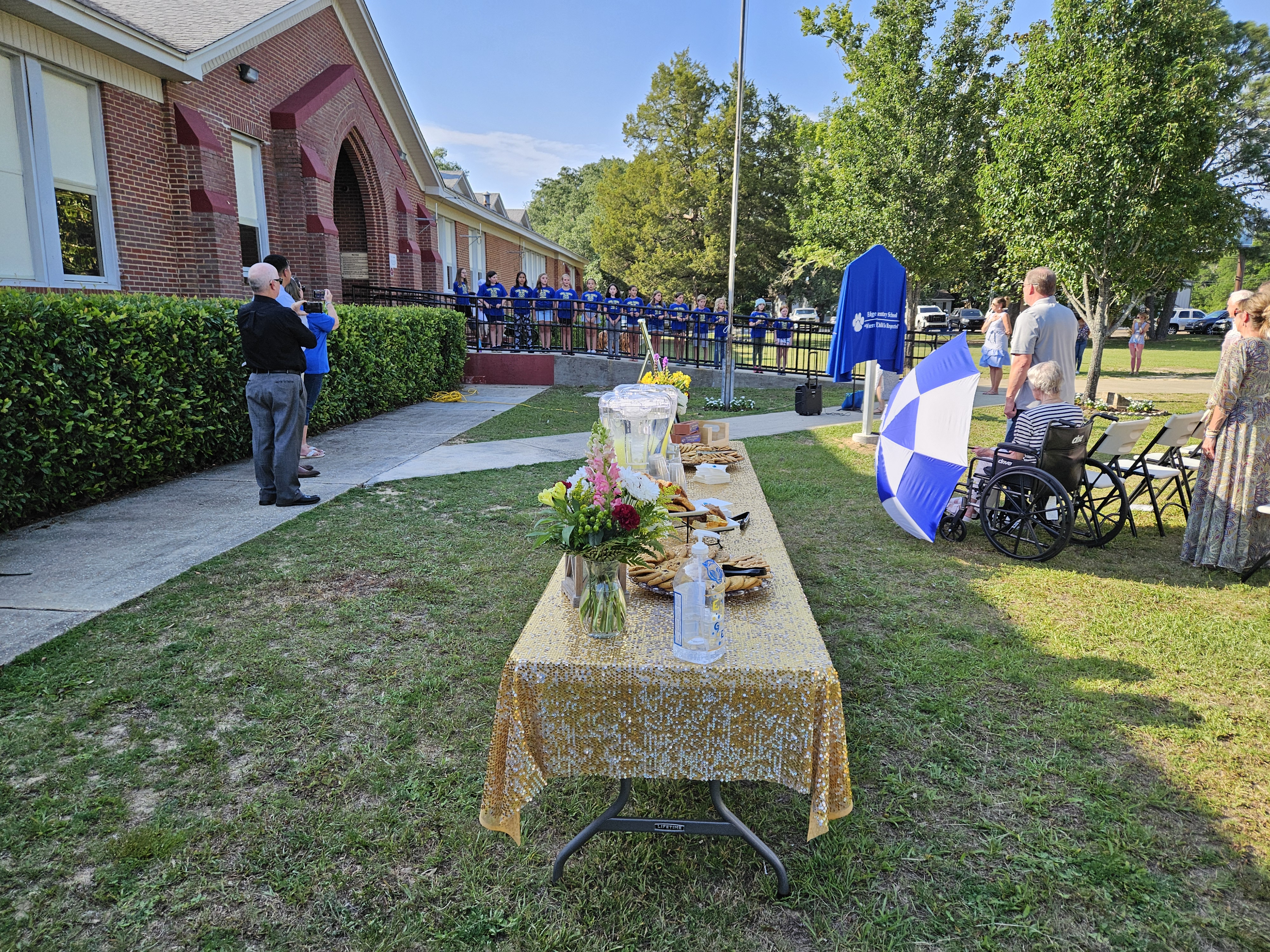
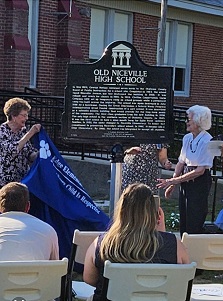 |
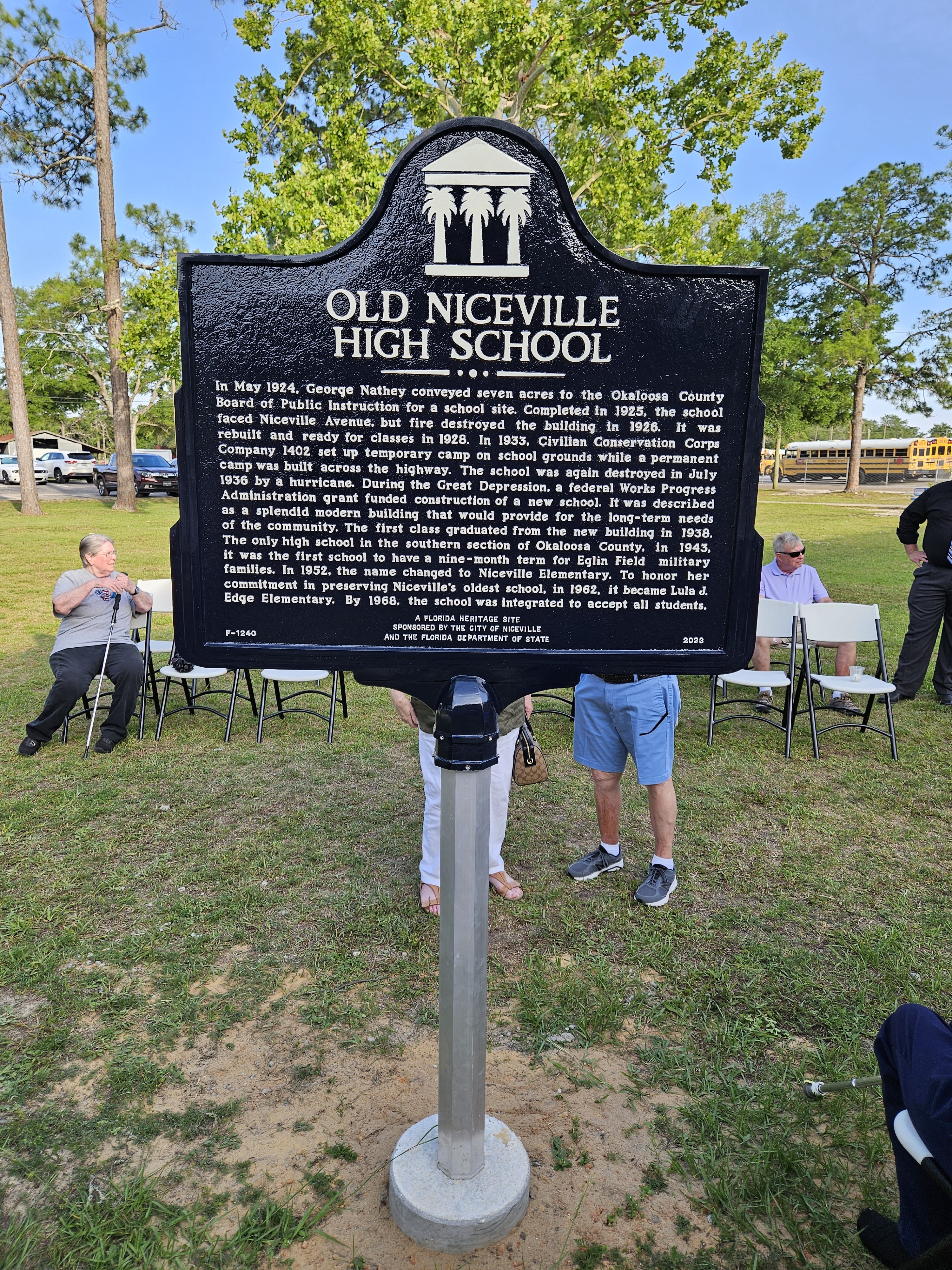 |
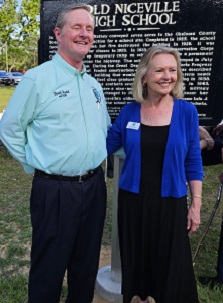 |
The Setting
Niceville’s roots cannot be removed from the counties it has been located in. Florida was a Territory in 1821 and started with two counties, Escambia to the West and St. Johns to the East divided by the Apalachicola River. This placed Boggy Bayou in Escambia County. Boggy Bayou was in Walton County in 1824 when that county was established. After Boggy, Florida became Niceville it was in Walton County five more years before Okaloosa County was formed in 1915. In 1910 when Boggy, Florida became Niceville, Florida the area known today as Destin and the Beaches of South Walton was in Washington County. The name of the Bay changed from its original name, Santa Rosa Bay to Choctawhatchee Bay and at times in history was known by both names. The name of the creek at the head of Boggy Bayou was known as Boggy Creek then Juniper Creek and is known today as Turkey Creek. Santa Rosa County was established in 1842 with its county seat at Milton, placing Boggy Bayou near the boundary of Santa Rosa County and Walton County. In 1857 William Nathey built the gristmill on today's Mill Creek. Today that site is on Eglin's Golf course. The gristmill was on public land included in the homestead received by Warren Armstrong forty-four years later. Although the Nathey Gristmill stones are the oldest artifacts of the European community they are not located in Niceville.
Because of its location on Choctawhatchee Bay, Boggy Bayou was not bypassed by the Civil War. Early in the war it was a fall back location for the Walton Guards when challenged by Federal forces. For some Unionist escaping to Federal blockade ships at East Pass, it was a crossing point. The Federal blockade brought hardship to those in Boggy Bayou as commerce, particulary timber exports, through Pensacola was cut off by. For the Mobile campaign toward the close of the war it was a Federal departure point. (Look for Civil War information on this website.)
In the early 1900's settlers homesteaded up to 160 acres each around Boggy Bayou and Rocky Bayou. Some descendants of these men live in Niceville today. Some families have resided in Niceville for eight generations.
Communities were recognized when mail service was established or when a Precinct number was assigned.
Boggy was recognized as a community when mail service to Boggy Bayou was established in 1868. In 1881 a mail route from Mary Esther in Santa Rosa County to Boggy Bayou in Walton County, a distance of 20 miles, was established. In 1887 a mail route from DeFuniak Springs to Boggy Bayou via Alaqua, a distance of 45 miles, was established. In 1910 the post office name was changed from Boggy to Niceville. (Look for mail service information on this website.)
Early in Florida's land dispensations, some parcels along Choctawhatchee Bay, Boggy Bayou and Rocky Bayou were transferred from the United States to the State of Florida and from the State to the Railroad Companies. The Railroad Companies sold land to the lumber and timber companies. After removal of the trees, the swamps were drained and the land could be developed. When Boggy’s name was changed to Niceville in 1910 it was surely in an effort toward development. Perhaps the name was chosen for Nice, France because like Niceville, it is located at the northern point of a beautiful bay that also has a temperate climate. Developer Robert E. Lee McCaskill wrote in his pamphlet: The Road to Health Happiness Prosperity, "This Western portion of Florida, lying as it does for its whole length along the Gulf of Mexico, has been named the Riviera, because of its likeness to the world famed play ground of Europe, lying along the Mediterranean Sea on the northwestern part of Italy and southern shores of France. It will be observed that this district lies unuaually high above sea level."
In the 1880 census, Precinct No. 9 was assigned to Boggy Bayou. Boggy had 37 households. This may not seem like a significant number until compared to the first census for Valparaiso in 1930 that had just 38 households. From 1880 until 1930 the population of the surrounding area of Boggy Bayou was reported as one community. The 1910 Niceville population, reported as Boggy (with Bayou inserted) consisted of 237 households. The 1930 Niceville census had 202 households with a population of 824.
The River and Harbor Act of 1892 allowed for the Choctawhatchee Bay and the Santa Rosa Sound to be dredged making transporting products for export to Pensacola more accessible. In addition to lumber, considerable cattle, wool, wood, sheep and cotton was brought from the lower Choctawhatchee River and Bay to Pensacola on schooners and on barges towed by tugs. Pensacola was the distribution point of supplies for all settlements bordering on, and adjacent to, the waters of Choctawhatchee Bay. The commerce passing through Santa Rosa Sound was estimated at $800,000 annually. Calculated by the worth of a dollar from 1892 to 2010 that value would be about $19,760,000.
Boggy, Florida is on the state of Florida map in 1895.
In the early 1900's the Eaton Sawmill was located at Boggy, Florida. Then the town became an even larger milltown when Daniel P. McKenzie from North Carolina brought his business expertise to Boggy where he lived with his family. He is responsible for the growth of the portion of Niceville located on the west side of Boggy Bayou.
An article in the Pensacola Journal dated November 25, 1908 reported: "The McKenzie Mill Company of Boggy bought the mill machinery of the Robinson Sawmill for the purpose of carrying it to Boggy to be set up. A large boiler and smoke stack were loaded on the schooner Evelyn at Jefferson Street wharf to be placed in the saw mill of the Consolidated Land and Lumber Company at Boggy Bayou. The Boggy Mill Company was running its plant on full time, cutting about 21,000 board feet per day. The mill of the Consolidated Land and Lumber Company will be ready to start up within a short time. Boggy is becoming one of the best towns in this section. The name Boggy signifies that it is bogged up with business. There are about ten buildings in the course of construction and everyone is busy. New families are locating rapidly, and at the present time the town has four stores, two mills and two stills."
Daniel P. McKenzie owned two sawmills, one on each side of Boggy Bayou. Each mill had its own commissary. In addition to its sawmills and naval stores industry Boggy, Florida also had a shipyard and a fish business. A Pensacola Journal article dated December 20, 1908 stated that the worth of the Consolidated Land and Lumber Company's two sawmills at Boggy, Florida and about 12,000 acres of timber in Santa Rosa and Walton County were valued at $60,000. Calculating the value in 2010 that corporation would be valued at about 1.5 million dollars.
On July 23, 1909 the Pensacola Journal reported: "News from Camp Walton: On Saturday the proprietors of the Swan kindly invited the ladies and Mr. Colver to an afternoon and evening ride on that boat to Boggy, Garniers, Rocky and other bayous, and to Marler's at Destin. A nice lunch was furnished on the boat. The trip was simply delightful, particularly the ride up Boggy bayou, with its mills and nice places to view along its shores, such as the Parish landing and the Woodmen of the World home. Mr. Parish, who is quite a vessel owner, is a brother to the Walton county judge. One of the mill owners at Boggy, Mr. Crawford and his wife, were on the Swan, returning from Pensacola, and helped to make the trip interesting. McKenzie seemed to be doing a rushing business with his mills, and is building up a nice village on the west bank of the bayou. The name of Boggy should be changed to Bayou Grand, or Live Oak Bayou, as the name Boggy gives a stranger a wrong impression of a bayou that has deep, clear water, and high and dry shores a half mile apart." (Note: A portion of Niceville that was located on the west side of Boggy Bayou was incorporated as the City of Valparaiso in 1921.)
On November 5, 1910 Boggy became Niceville, Florida.
R. E. L. McCaskill was the most imposing personality in the early development around Boggy Bayou. In July 1912 J. P. Rawls bought the Boggy Mill Company at public auction and sold it to the Mutual Land and Lumber Company owned by R. E. L. McCaskill in October 1912. In November 1912 D. P. and Louise McKenzie sold to the Mutual Land and Lumber Company owned by R. E. L. McCaskill land formerly owned by F. C. Eaton at the west side near the head of Boggy Bayou. McKenzie also agreed that for a period of 20 years that he would not engage in the sawmill business in either Walton or Santa Rosa County within a distance of 15 miles from Boggy, Florida. After acquiring these Boggy based businesses, R. E. L. McCaskill was in a position to control development around Boggy Bayou. If he had not, surely someone else would have. With its location mid-way between Pensacola and Freeport, every water vessel coming and going between these two points passed Boggy Bayou.
Congress passed the Federal-Aid Road Act of 1916 because of rural interests to “Get the farmers out of the mud!” But before the program could get off the ground, the United States entered World War I. (Some men that served in WWI are listed in Niceville 1917 - 1929.) In Okaloosa County, the elected officials and citizens took it upon themselves to build and improve existing roads. Niceville grew as roads in and out of the area were improved. In 1916 G. B. Anchors and W. Howell each owned a car, with a total of six cars in Niceville. In 1917 B. P. Edge purchased a car from The McCaskill Motor Company. R. E. L. McCaskill and Kenneth McCaskill were Agents for Halladay Motor Cars of Streator, Illinois. The McCaskill’s had dealerships at DeFuniak Springs and Pensacola. They offered seven different models priced from $1,125 to $2,750. The local history is not beholding to one benefactor, although John Jett (J. J.) McCaskill ("known for more than a quarter of a century for having done so much for the development of this section of the state") and his son R. E. L. McCaskill of DeFuniak Springs and Freeport were vast land owners in the area, responsible for much of the early development along Choctawhatchee Bay.
Niceville is on the 1917 Okaloosa Co. Railroad map.
In the 1920 Niceville Census John Perrine was President and Charles H. Lear, Sr., was Manager of the Valparaiso Development Company. The population of Niceville, which included today's Valparaiso, was 185 households. The primary occupations in both 1910 and 1920 are laborers at the turpentine farms and sawmills, shipbuilding and fishing. Possibly the only land purchased by John Perrine in Okaloosa County was 268.33 acres located on Rocky Bayou from the R. E. L. McCaskill Company on April 6, 1921. Mary Perrine, Leslie Frank Perrine and Charles Perrine purchased land in Valparaiso from William McCollum. James Plew purchased the bankrupt Valparaiso Development Company from William McCollum on March 1, 1922. Later, James Plew purchased property in the Boggy Bayou area from R. E. L. McCaskill and William McCollum, including land in Niceville, property his descendants have continued to own, develop and sell. (see West Side Boggy Bayou)
Niceville residents voted to incorporate on July 7, 1938.
As expressed on July 8, 1938 in a Okaloosa News Journal article: "With sentiment apparently running favorably, Niceville voters went to the polls yesterday to ballot on the question of incorporating the town. Returns had not been announced at the time the News-Journal went to press. Several meetings, well attended by townspeople, were held for discussions of pros and cons before the matter was submitted to the voters. Advantages of incorporation for a growing town, particularly with regard to water and sewer systems, law enforcement, and street improvement were stressed. It was also pointed out that a badly needed cold storage plant would be more readily available to an incorporated town through federal aid. Niceville is one of the largest voting precincts in Okaloosa county. Its population is at present about 1,000. Under the terms of the proposed incorporation, Niceville’s limits would be extended to include about double this number."
House Bill No. 1302 "to establish the municipality of the City of Niceville" was passed by the Florida Senate on May 25, 1939.
Sources and Credits
On this website can be found a portion of the rich history of Niceville up through the late 1940s.This documentation for this website has been gleaned from maps, census records, newspaper articles, books, the Okaloosa County museums, warranty deed records from Walton County and Okaloosa County,and the Special Collections Department at the University of West Florida, 1881 Florida Legislation and from contributors. Your collaboration is welcomed in documenting the households, landowners, businesses, churches or other historical information through the 1940's. If you have documented information, including ancestors who homesteaded on Boggy Bayou or Rocky Bayou and/or served in the Civil War from Boggy Bayou, that you wish to contribute to this Niceville Heritage Project please contact the Author/Webmaster. Unless noted otherwise, maps used on this site can be found at the University of South Florida’s map website.
Aboriginal Sites::
ExploreSouthernHistory.com - Fort Walton Temple Mound, Florida
The Northwest Florida Expeditions of Clarence Bloomfield Moore (from 1901 - 1918) pages 80-81
Florida State Archives, Aboriginal Sites
Homestead descriptions:
The Bureau of Land Management - Government Land Office.
Schools contributors:
Dr. Bill Smith, Program Director of
Facilities, Okaloosa County (Florida) School District
Photo of George and Agnes (Wise) Nathey: Courtesy of Lois
Nathey Higgins
Photos Old NHS Class of 1932: Courtesy of Freida Spence
Choctawhatchee National Forest and Civilian Conservation Corps contributors:
James Cusick, Curator, P. K. Yonge Library of
Florida History, Department of Special and Area Studies
Collections, George A. Smathers Libraries, University of Florida
Robert G. Pasquill, Jr., Forest Archeologist/Historian, Heritage
Program Manager, National Forests in
Alabama
SSgt Kristina Dean, The Air Armament History Office, Eglin Air
Force Base, Florida
Rhonda L. Kimbrough, Heritage Program Manager, National Forests
in Florida
Joe Meyer M.A., RPA Archaeologist CEMML CSU 96CEG/CESVH,
three photos CCC 1402 Camp, F-3,
August 8, 1935
Ann Spann, Baker Block Museum, Okaloosa County
(Florida), 1936 CCC Annual, District "G"
Mail Service contributor::
Jeanette Courtney Henderson, Curator Emeritus, Baker Block Museum, Okaloosa County (Florida)
1940 Federal Census for the U. S. Army Air Port (Eglin
Field) at Niceville Precinct
#14 transcribed by:
Jim Young, Editor, The Genealogical Society of Okaloosa
County, Florida Newsletter
Eglin Field:
Paul Freeman, Abandon & Little-Known Airfields: Florida, Eglin Area
History of Eglin Air Force Base: Base Railroad, Wikipedia
Staff Sgt. Mike Meares, 96th Air Base Wing Public Affairs,
Inside Eglin AFB, 4/18/2007
Photo B-25B Eglin Field 27 March 1942, Bryan Swopes, This
Day in Aviation; thisdayinaviation.com
Photo Doolittle Raiders Highway sign courtesy of John Higgins,
USAF Retired
Photo White Point Student Housing, Florida Memory, Division of Library
and Information Services
Photos courtesy of The Heritage Museum:
The Nathey Gristmill circa 1905
The Nathey Gristmill circa 1921
Photo courtesy of Hiram (Ed) Oneal:
Charles Beck
Esmond F. Griner
Photos courtesy of Marsha Smith Ankeney:
Simeon Burlison Civil War pension application
Rebecca Burlison Civil War widow pension application
The Boggy School 1903
Noah Edward Burlison Woodmen of the World 1911 Grave Marker
The Bolton Sisters
James T. Bolton Family
James F. Burlison
Niceville school construction photo
Photo courtsey of Dorothy Nathey Stanley:
William John and Mary Jane Bolton Nathey
Photos courtsey of Rhonda L. Kimbrough, Heritage Program Manager, National Forests in Florida:
Captain Inman F. Eldredge
Camp Pinchot Fire Tower Complex
Photos courtesy of Rogene Anchors Hasty:
Noah Edward Burlison
Niceville School 1929
Niceville High School 1930 Graduation Program
Niceville High School 1930 Graduating Class Photo
Niceville Methodist 1929 Tent Meeting
First Methodist Church of Niceville bulletin
Forest Service Building, Jackson Guard, Niceville
G. B. and Pearl Anchors
Ranger Station Residence, Jackson Guard, Niceville
Ranger Station Garage, Jackson Guard, Niceville
Niceville Boy Scout Troop in 1927
Army Cpt. Harold Heminer of CCC 1413, Niceville
Niceville High School 1941 Beta Club officer
Niceville High School 1942 Graduating Class
Niceville High School 1942 Baccalaureate Service
Photos courtesy of Charlene Levey Holler:
R.E.L. and his son Harold McCaskill
R.E.L. McCaskill circa 1920
Photo courtesy of Jo Nagel:
Fred L'Orange
Photo from The History of Walton County By John L. McKinnon:
Four generations of McCaskill's.
Photos from DeFuniak Springs (Images of America: Florida) by Diane Merkel and Walton County Heritage Association:
Young R.E.L. McCaskill
Florence McCaskill with children and attendant in pony cart